The ‘Peach state’ is much more than just the birthplace of Coca Cola. It’s a great place for birdwatchers and other wildlife enthusiasts to get a glimpse of Nature at its best. Today we are going to talk about the fine feathered denizens of Georgia that might just pay your backyard a visit. We’ll also go into locations that you can visit when you feel like getting out of the house or if you happen to be a tourist who wants to see a little wildlife that you might not be able to see at home. Let’s talk about the popular backyard birds of Georgia!
3 Categories – 347 Birds
Georgia has 347 noted Avian species that like to frequent the Peach state at various times of the year. While we, of course, cannto catalogue them all, what we CAN do is give you 5 favorites that you can see at various times of the year. We’ll divide the seasons up like this:
- Year-round Resident birds
- Birds of Spring, Summer, and Early Fall
- Fall and Winter Birds
In each section you’ll see bird listings that include their appearance, preferred habitats, size, and diet tips for luring them into your backyard for feasting and fun. Without further ado, let’s get started!
Georgias’s Year-Round Resident Birds
Example: These birds are dedicated to their home state and they stick around from January through December. This means that at any time of the year you might be lucky enough to spot one flittering around in your backyard or gracing your garden. The year-round residents we will focus on today are the following birds:
- Yellow-rumped Warbler
- Chipping Sparrow
- American Goldfinch
- Pine Warbler
- Eastern Towhee
Yellow-rumped Warbler – Setophaga coronata

Coloration and Markings: The Yellow-rumped Warbler has gray wings, tail, and back with broad, white lines towards the central part of the wing. The upper breast is gray, becoming white as you look to the underbelly, and underneath each wing towards the shoulder you’ll see distinctive yellow patches. Facially, this bird has a bright, yellow chin with the rest of the head being a soft, lovely gray. Curved white lines are present above and below the eye and this bird has a medium-sized, straight black bill.
Size: This bird measures in at 4.7 – 5.5 inches from tip to tail with a wingspan of 7.5to 9.1 inches.
Habitat: These birds are fond of coniferous forests but they may be found in many places, including coastal locations, parks, and backyards.
Diet: These birds like a lot of things… for best results we recommend suet, peanuts, raisins, and Sunflower seeds. This gives them a little bit of everything and will keep them coming back for more.
Chipping Sparrow – Spizella passerina
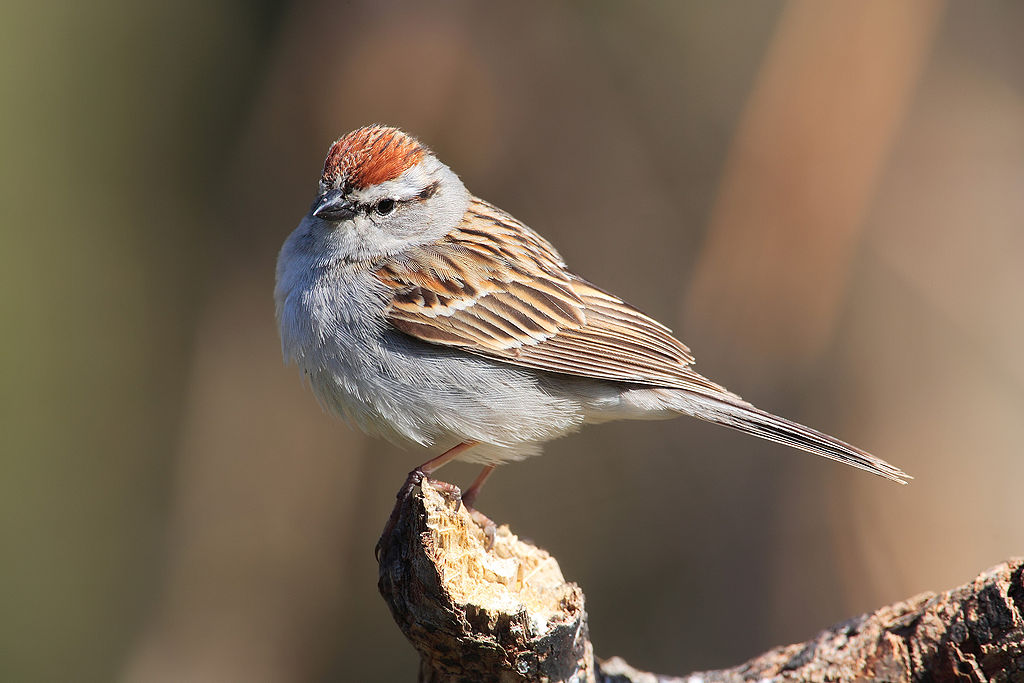
Coloration and Markings: Chipping Sparrows have brown wings with black streaks and gray, streaked tails. By contrast, their breast and underbelly are a soft gray which extends up to the face. Facially, you will notice lighter shades of gray which create a curving line, framing the bird’s cheek, and a thin, black line that travels across the eye to the back of the head. This bird has a rusty crown with a short, stout black bill, and you may notice the crown turns black where it connects to the bill.
Size: Roughly Sparrow-sized, this bird measures in at 4.7 – 5.9 inches in length with a wingspan of approximately 8.3 inches.
Habitat: Open, wooded areas are attractive to this bird. They are not shy and happily visit both parks and backyards.
Diet: These birds are easy to attract. If you have Black Oil Sunflower seeds in your feeder then these Sparrows will happily gorge on them.
American Goldfinch – Spinus tristis

Coloration and Markings: The American Goldfinch is easy to identify. They have a bright, yellow back and black wings with white markings, such as a a curved white line across the back of the wings when folded and vertical lines across it’s long tail. The breast is yellow, as is the underbelly, but you will notice a tuft of white towards the rump which continues across the underside of the tail. Facially, this bird has the same body-yellow on its face along with a black cap on the forehead that stops at the bird’s small, orange conical bill. Females have olive coloration instead of the black and more subdued yellow colors and both genders appear brown in the Winter though their wingbar markings will still be present (though very light!).
Size: These birds measure in at 4.3 – 5.1 inches in length with wingspans of 7.5 to 8.7 inches.
Habitat: These birds are commonly seen in fields and anywhere you can find thistles or thickets. They also love backyard feeders so be sure to think of them when you are filling that feeder up and you might just get visitors.
Diet: Nyjer and Sunflower seed are all that you need to keep these little rays of sunshine happy. Stock up that feeder and watch ‘em go!
Pine Warbler – Setophaga pinus
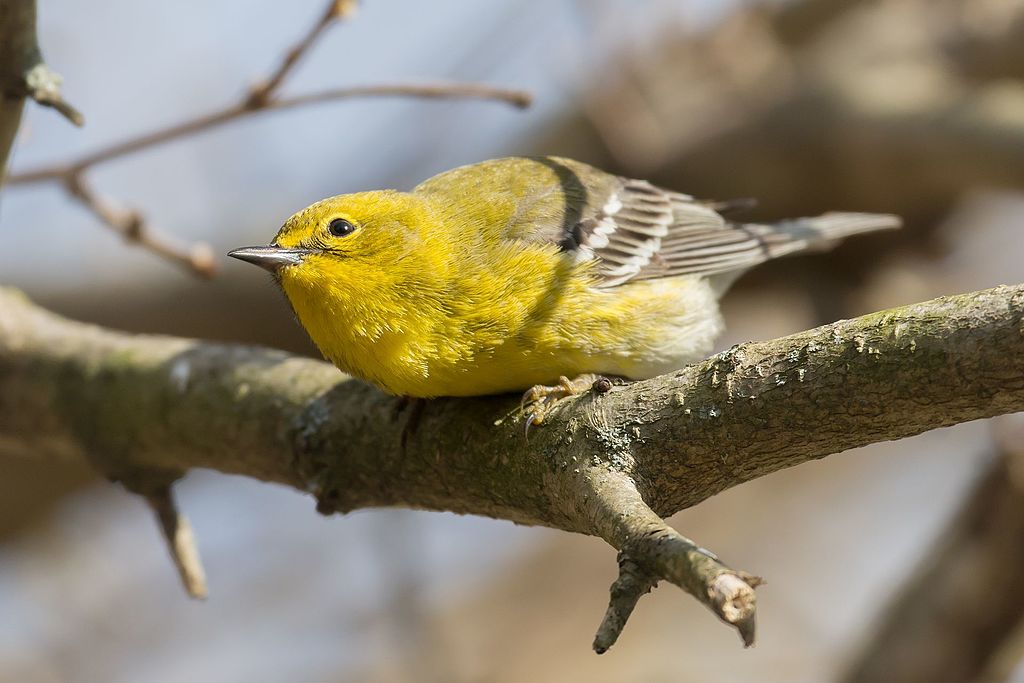
Coloration and Markings: Pine Warblers have olive backs and wings, with the wings containing white wingbars and highlights along the tips as well as short, olive tails. They have yellow breasts with some black, giving the yellow a ‘dirty’ appearance, and their underbellies are white. Facially, they are yellow, although with the ‘dirty’ black thrown in so that the eye appears outlined. It gives the appearance that they are wearing glasses on their short, straight black bills. The females are less colorful and sometimes limited to gray-brown color configurations of the same markings.
Size: These birds measure from 5.1 – 5.5 inches from head to tail with wingspans of 7.5 to 9.1 inches.
Habitat: These birds are found in deciduous forests where they regularly perch and play in Pine trees. They are also backyard regulars, however, as they are very fond of feeders.
Diet: These birds have a varied diet. You can lure them with foods such as cracked corn, suet, millet, Black Oil sunflower seeds, or simply by having fruiting vines or trees in your garden.
Eastern Towhee – Pipilo erythrophthalmus

Coloration and Markings: The Eastern Towhee has sooty black wings with a small amount of white highlights as well as a white-tipped tail. It also has white down the center of the belly and breast with brownish-orange on the sides. Facially, this bird has a black throat and face with a small, but pretty crest and a short, stout black bill. Females have the same appearance except that they will be brown instead of black.
Size: Roughly Robin-sized, these birds measure in at 6.8 – 8.2 inches in length with wingspans of 7.9 to 11 inches.
Habitat: Dense shrubberies, thickets, and brush… These birds love to forage in these areas of the forest’s edge for the relative safety this vegetation provides.
Diet: There are many good combinations that you may employ, just select one of the following: White Proso millet, oats, cracked corn, or peanuts.
Georgias’ Birds of Spring, Summer, and Early Fall
Spring, Summer, and Fall are all excellent times to be in Georgia. Spring is ideal but in any of these 3 seasons you can meet up with a number of feathered wonders to take a glimpse of or if you are lucky, that perfect photograph. Look for these birds during the spring, summer, and early fall in Georgia:
- Ruby-throated Hummingbird
- Tufted Titmouse
- Indigo Bunting
- Blue-gray Gnatcatcher
- Yellow-throated Warbler
Ruby-throated Hummingbird – Archilochus colubris
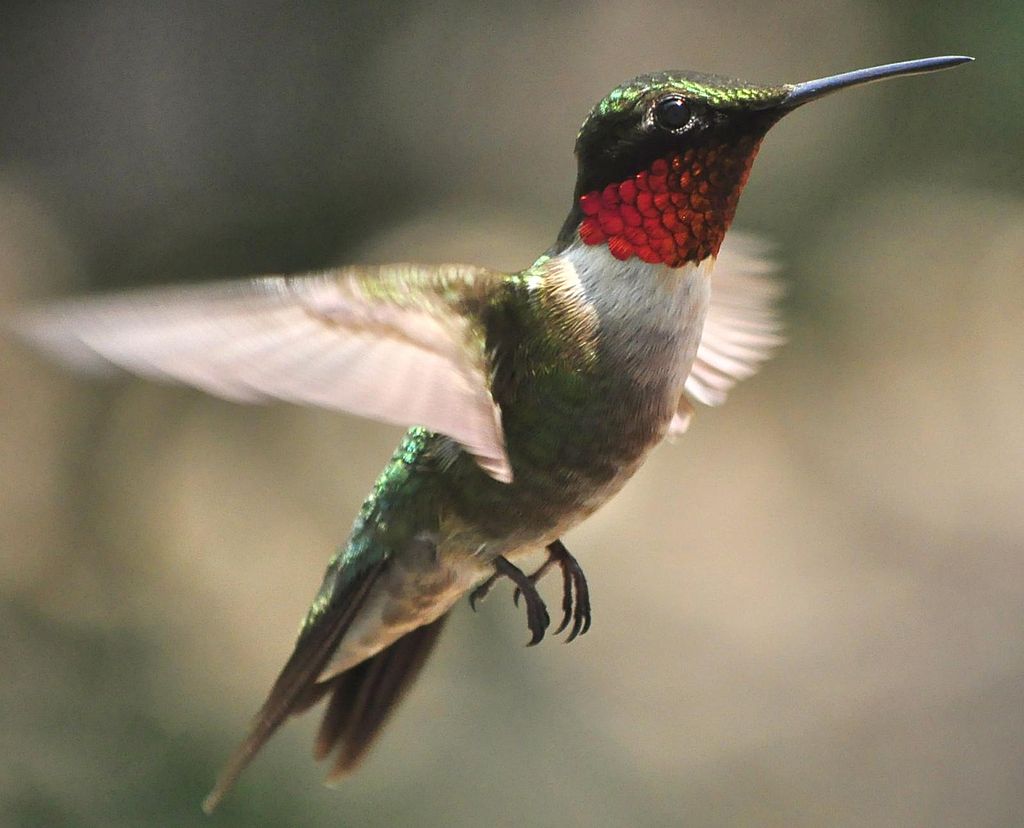
Coloration and Markings: Ruby-throated Hummingbirds are beautiful little creatures. They have olive-colored (sometimes purple) wings and tail along with a gold-green or emerald-green back. They have a white breast, with the white flanked by a light emerald and olive ‘vest’ down to the rump, where their plumage turns white until the olive underside of the tail. Facially, their throat is a ruby-red color that extends to the back of the neck, which is just under a wide black mask. Above the mask, the tops of their heads are an emerald color and they have long, slender bills which curve slightly down.
Size: This tiny little bird measures in at only 2.8 – 3.5 inches in length with a wingspan of 3.1 to 4.3 inches.
Habitat: These birds sometimes frolic at the forest’s edge and are fond of other open areas, such as meadows, parks, and gardens.
Diet: You can mix ¼ cup of sugar per cup of water to make a yummy drink for them that simulates nectar but change it often when it’s hot out. This mixture can ferment and turn to alcohol and this can make them very sick.
Tufted Titmouse – Baeolophus bicolor
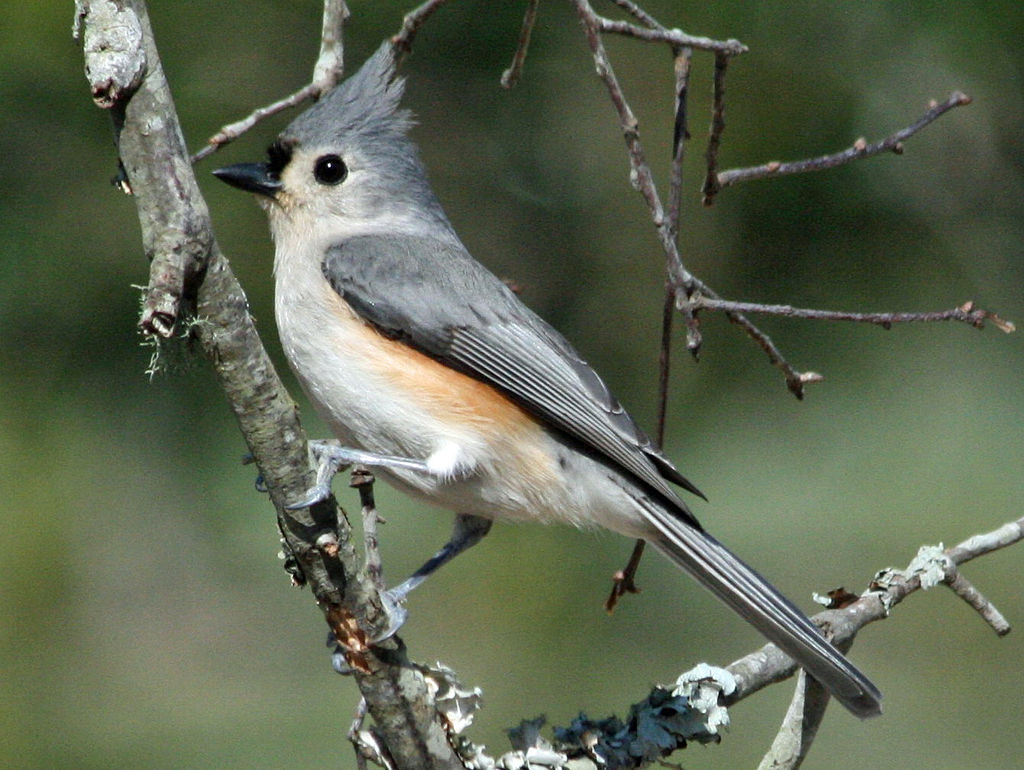
Coloration and Markings: Simple but elegant, these birds are gray and blue on their back, wings, and tail. On their breast and underbelly they are white, with some peach coloration towards the lower bellt. Facially, these birds are white with the exception of the upper part of the head. Starting just above the eye and bordering on a curve down the cheek this bird is grayish-blue and it exhibits a cute little crest. A black mark above the short and slightly curved bill gives this bird a ‘snub-nosed’ appearance.
Size: Thesebirds measure in at 5.5 to 6.3 inchesin lengthwith wingspans of 7.9 to 10.2 inches.
Habitat: You can find the Tufted Titmouse in deciduous forests as well as backyards. They are especially fond of Evergreen trees and love to visit feeders, so leave out a little something for them and they might just delight you with a visit.
Diet: Peanuts and suet will lure them to feeders but they really LOVE Black Oil sunflower seeds.
Indigo Bunting – Passerina cyanea

Coloration and Markings: Indigo Buntings are breathtaking and easy to identify. These birds are almost completely a rich Indigo-blue all over their bodies. While you will see some gray highlights in the wings sometimes this is one of the few exceptions. The other exception comes when you get to the face, where the Indigo Bunting has a black line which resides over its stout, silver bill and stops just short of the eye. This gives the eye a small, vertical outline in front. The head is a deeper blue than the body, finalizing the distinctive look of this beautiful creature.
Size: This small bird measures in at 4.7 – 5.1 inches in length with a wingspan of 7.5 to 8.7 inches.
Habitat: You can find the Indigo Bunting at the forest’s edge wherever the vegetation gets thick. They love brush and thickets.
Diet: Nyjer and mealworms are a knockout combination for keeping these little guys happy and coming back for more.
Blue-gray Gnatcatcher – Polioptila caerulea

Coloration and Markings: The Blue-gray Gnatcatcher has blue-gray wings with some black highlighting towards the outer edges and very animated medium-sized black tails. The breast and underbelly of these birds is snow-white and the color extends up all the way until just under the eye, neatly bisecting the face into 2 colors –blue-gray and white. On the upper blue-gray portion you’ll notice an ‘angry eyebrow’ line in black which starts at the small, slightly curved black bill and continues to the end of the eye. The eye of this bird has a noticeable thin, white outline.
Size: Almost Hummingbird-sized, these diminutive flyers measure in at 3.9 – 4.3 inches in length with wingspans of approximately 6.3 inches.
Habitat: These birds frequent deciduous forests but they also love general areas of dense vegetation where shrubs and thickets are present.
Diet: These birds are insectivores and as such you might try mealworms but there is a minimal chance that this will work. That said, plant life that promote insects DOES attract these little guys, so if you have a Cherry, Oak, or Maple tree then one of these might well bring a Blue-gray Gnatcatcher in for a visit.
Yellow-throated Warbler – Setophaga dominica

Coloration and Markings: The Yellow-throated Warbler is a real looker. The wings and tail are white with black streaks while the breast, underbelly, and the underside of the tail are paper-white. At the top of the breast up to the chin this bird has a trademark bright yellow coloration which stops at the shoulder of the bird and the border of its brilliant black mask. This large mask covers the eye, extending a thin line just after the eye which goes to the back of the head, and the main portion of the mask also curves down over the cheek, first wide and then becoming thin as it pulls back towards the shoulder. This bird has a long, thin, and very slightly curved black bill. Females will have the same markings but their colors are noticeably subdued.
Size: This bird measures in at 5.5 – 5.5 inches in length with a wingspan of approximately 8.3 inches.
Habitat: These birds love Pine forests and they are also fond of water, so it’s not uncommon to find them in marshland or near ponds.
Diet: These birds eat mostly insects although we have read reports of Yellow-throated Warblers visiting suet feeders, so give this a try and see what happens.
Georgia’s Fall and Winter Birds
Georgia has relatively minor winters (a blessing for most!) but there are still some birds that you don’t see during this time. We’ve collected a few examples of birds that you DO see during a Georgia winter so that you keep an eye out for them. Watch for the following birds this winter:
- Ruby-crowned Kinglet
- Song Sparrow
- House Finch
- Vesper Sparrow
- Brewer’s Blackbird
Ruby-crowned Kinglet – Regulus calendula
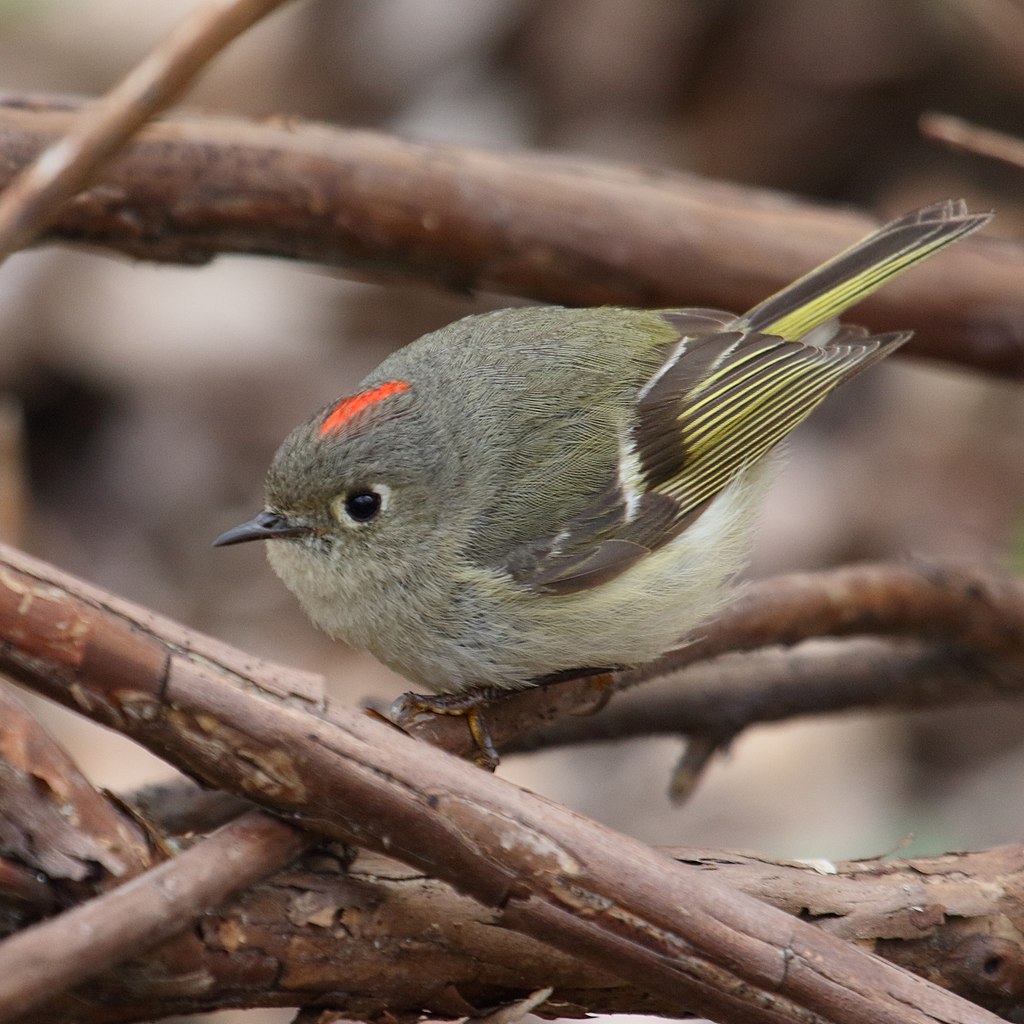
Coloration and Markings: The Ruby-crowned Kinglet is mostly olive-green overall. Their wings do have white wingbars, often bordered in black, and some brighter greenish highlights are often present in both the wings and its long tail. The breast and underbelly of this bird are white and gray and facially this bird has an olive-gray face with a very noticeable white outline of the eye. The male birds have a rest crest, which is the ‘crown’ from which this bird’s name is derived.
Size: These little guys measure in at 3.5 – 4.3 inches with a wingspan averaging 6.3 to 7.1 inches.
Habitat: Fond of coniferous forests and dense shrubbery, the Ruby-crowned Kinglet also frequents parks and backyards.
Diet: While they mostly eat insects they do occasionally vary their diet. Small Black Oil sunflower seeds and assorted berries will do the trick.
Song Sparrow – Melospiza melodia
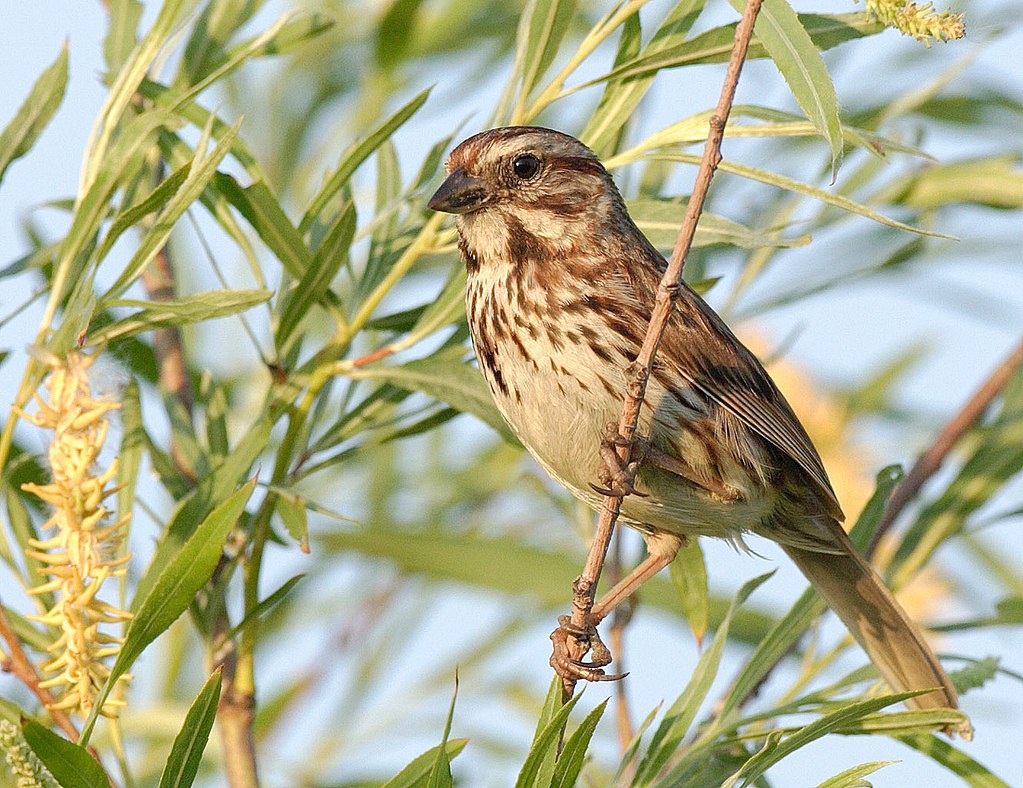
Coloration and Markings: Song Sparrows have brown and gray streaked wings, with some gray at the tips of each wing, along with small brown and gray tails. The breast and underbelly is also brown and gray streaked, though close to the rump these are touches of white thrown into the mix. Facially, the brown and gray are done in broader streaks going across the head and there is a white line which travels from the bill and curves first down and then upward, accenting the cheek. These birds have small, but stout gray bills.
Size: These birds measure in at 4.7 – 6.7 inches and have wingspans of 7.1 to 9.4 inches.
Habitat: These birds like large, open areas such as the forest’s edge or a nice, weedy field. They like water too and it’s not uncommon to see them near ponds or marshes. That said, they like to build their nests in the suburbs so they aren’t shy about people. These birds love backyard feeders.
Diet: Black Oil sunflowers seeds, oats, and wheat are 3 simple ingredients for making a happy Song Sparrow.
House Finch – Haemorhous mexicanus
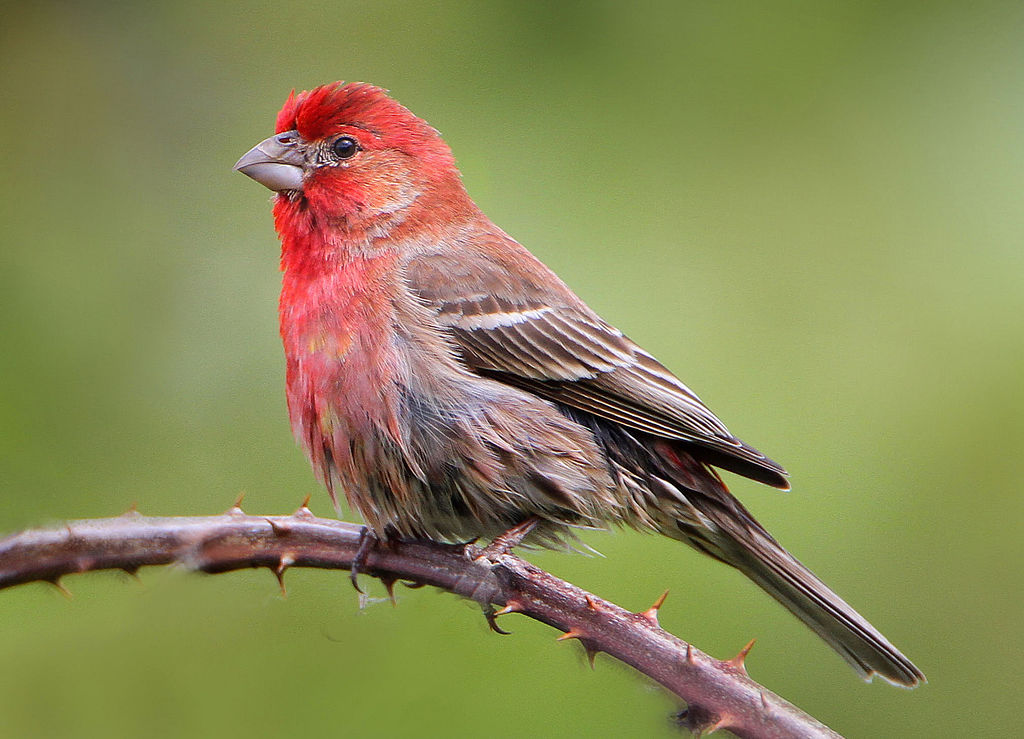
Coloration and Markings: As with many birds, the male House Finches get the really impressive markings. The wings and back of this bird are streaked brown and black (sometimes gray) while the underbelly and the lower half of the breast are a lighter grayish brown with some faint red streaking. Continuing upward the rosy-red becomes more apparent, as the upper half of the bird’s breast becomes quite saturated with red additions to the gray. Facially, you will see some gray underneath the eye in front of the silver-gray bill but most of this bird’s face will be rosy-red. You will see some gray outlining from the back of the eye and curving around to highlight the cheek, also forking towards the back of the neck. The females do not have any red coloration and are grayish-brown only. .
Size: These birds measure only 5.1 – 5.5 inches in length and have a wingspan of 7.9 to 9.8 inches.
Habitat: Farms, forest edges, even deserts.. But especially areas inhabited by humans, these birds are quite diverse in what environments they may thrive in and they are avid visitors of feeders.
Diet: Black Oil sunflowers seeds will be eaten with abandon. These birds also thistle and just about any kind of berries that you have on hand.
Vesper Sparrow – Pooecetes gramineus

Coloration and Markings: The Vesper Swallow has brown wings with white streaks and accents as well as a long tail that has mostly brown and gray though the outer tail is white. There is also a tan splotch on the shoulder that is always present but it is difficult to see at first. This bird has a white breast and underbelly and while there is streaking, it is widely placed and thus much less prominent. Facially, this bird has the same brown and white streaking, albeit finer, right up to the bill. A noticeable white line also travels from the conical brown bill and under the cheek, stopping short of the back of the neck. This bird has a brown and tan cheek patch as well as a visible outline of white around the eye, while the upper half of the head is an orderly mix of brown and gray streaks, much more granular than on the rest of the body.
Size: Roughly Sparrow sized (though sometimes smaller), these birds measure in at 5.1 to 6.3 inches in length with wingspans of approximately 9.4 inches.
Habitat: Meadows and prairies… any open areas with tall grass are looked upon with favor by the Vesper Swallow.
Diet: While they chiefly eat insects, they will sometimes eat suet and they definitely like Black Oil sunflower seeds.
Brewer’s Blackbird – Euphagus cyanocephalus

Coloration and Markings: Not just any Blackbird, the chicken-walking Brewer’s Blackbird is a bird that you might be lucky enough to spot in your Georgia backyard. The male bird is a shiny black all over, although if it is bright outside you’ll also notice green and blue. It’s very pretty. The head has some definite blue in the black and these birds have very striking, bright eyes, as well as a medium-sized conical bill. Female Brewer’s Blackbirds will actually have dark eyes and are brown in color.
Size: These birds measure in at 8.3 – 9.8 inches in length with wingspans of 14.6 inches.
Habitat: Brewer’s Blackbirds prefer open areas, such as meadows or fields, and are quite urbanized. They know that where there are people, there is food, and so they aren’t shy when it comes to settled areas.
Diet: Like other Blackbirds, Brewer’s Blackbirds will eat just about anything. Suet, peanuts, and Black Oil sunflower will work, but if you really want to treat them then add a little fruit into the mix. That will keep them coming.
Supporting cast (Other Backyard Birds of Georgia That Might Pay You a Visit)
While we’ve gone over some birds to see during various seasons we thought it might be nice to give you 5 additional birds that you can look for year-round. These birds are categorized as ‘Supporting Cast’ but in this case it is a bit of a trick, as you’ll soon see from our first entry!
- Brown Thrasher
- White-breasted Nuthatch
- Eastern Phoebe
- Red-bellied Woodpecker
- Northern Mockingbird
Brown Thrasher – Toxostoma rufum
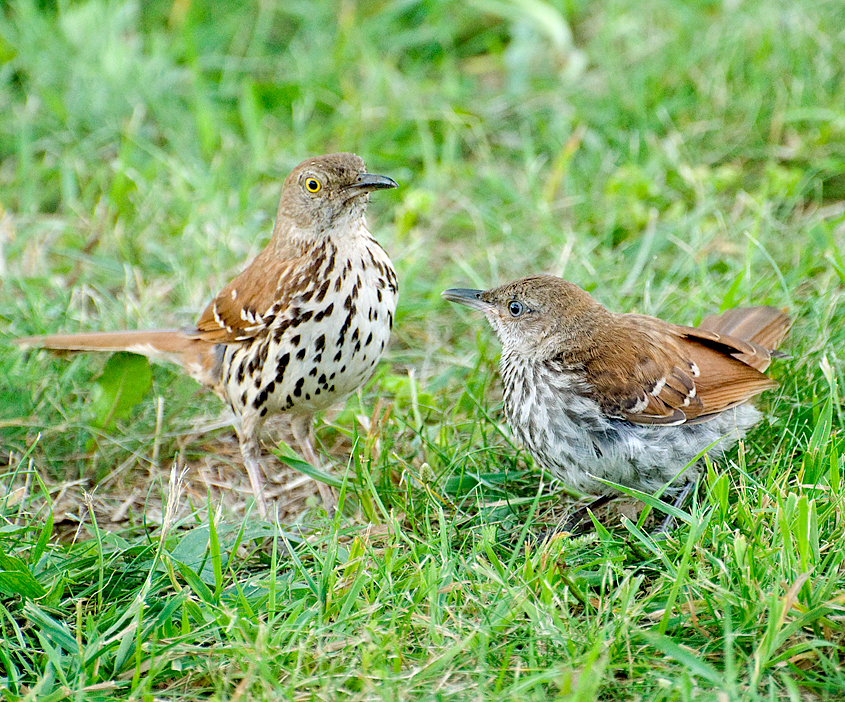
Coloration and Markings: Just to see if you’ve been paying attention we’ve placed the Brown Thrasher here in ‘Supporting Cast’. This bird was declared the State Bird of Georgia in 1935! They are good looking birds, too. The wings and back are a rich, deep brown while the breast and underbelly are are white with dark streaks. You will notice there are 2 black and white wingbars to be found on this bird as well. Facially, this bird has gray and brown in the center, with bright yellow eyes, and the remainder of the face is the same rich brown as the body.
Size: These are good-sized birds, measuring in at 9.1 – 11.8 inches from head to tail with a wingspan of 11.4 to 12.6 inches.
Habitat: Forest edges, fields, and anywhere else where the vegetation is dense. This bird prefers the coverage that such surroundings provide though on rare occasion they will leave these areas.
Diet: Cracked corn, suet, Black Oil sunflower seeds, and peanuts will be well-received by the Brown Thrasher.
White-breasted Nuthatch – Sitta carolinensis

Coloration and Markings: The White-breasted Nuthatch has blue and gray wings with black highlights and with a small amount of white at the tips of some feathers as well as on and underneath their tiny tails. They have a white breast and underbelly, although towards the rump it is not uncommon to see a brown-orange mark.
Size: These birds measure in at 5.1 – 5.5 inches in length with a wingspan of 7.9 to 10.6 inches.
Habitat: These birds like deciduous woods and can sometimes been see at the forest’s edge. They are especially fond of Oaks for their acorns and these birds are regular visitors to backyard feeders.
Diet: Peanuts and Black Oil sunflower seeds are an easy way to attract and keep the attention of a White-breasted Nuthatch.
Eastern Phoebe – Sayornis phoebe

Coloration and Markings: The lovely Eastern Phoebe has grayish-brown wings with some white highlighting seen when the wings are folded. They have small, grayish tails, and their breast and underbelly looks to be a fresh-bleached white. This white extend to the throat, chin, and a little above the shoulder of the wing for a ‘collar’ effect. Facially, though the chin is white, the rest of the head is a dark mix of grays and this bird has a small, slender black bill. In winter this bird may appear a bit yellow on the breast and underbelly and the white highlighting on the edge of the feathers is abit more pronounced.
Size: These birds measure in at 5.5 – 6.7 inches in length with an average wingspan of 10.2 to 11 inches.
Habitat: Open woodland areas are popular haunts of the Eastern Phoebe, as well as parks, woodland edges, and backyards. They are not shy around buildings or backyard feeders.
Diet: These birds are insectivores and we have heard reports of success in attracting them with dried mealworms.
Red-bellied Woodpecker – Melanerpes carolinus

Coloration and Markings: The Red-bellied Woodpecker has a Zebra-worthy pattern of black and white stripes on its back, wings, and tail that will definitely get your attention. Look closely when it is flying and you will also notice white patches at its wingtips. The breast and lower belly on this bird are white and there are faint patches of red that may be seen if the bird is close. This bird has a white face with the same splotching on the cheek and a magnificent red cap hich goes all the way to the nape of the neck. This bird has a long, straight black bill.
Size: This Woodpecker ia an attention-getting 9.4 inches in length (on average) and has a wingspan of approximately 13 to 16.5 inches.
Habitat: These birds love any forest with hardwoods in it and they are no strangers to backyard feeders.
Diet: Suet, Black Oil sunflower seeds, and peanuts are an easy and effective combination to give these big guys an energy boost between wood-pecks. Give it a try and see for yourself!
Northern Mockingbird – Mimus polyglottos

Coloration and Markings: Mockingbirds have gray wings which display 2 wingbars upon each wing. They have long, animated gray tails and are white of breast and underbelly. Facially, these birds have white chin and cheeks and often displaying a light gray outline encircling the cheek, starting from the back of the eye and circling around to the bill. The top half of the head is soft gray and they have short, slightly curved black bills.
Size: These birds measure in at 8.3 – 10.2 inches in length and have wingspans of 12.2 to 13.8 inches.
Habitat: When they aren’t hanging around the forest’s edge, these birds may be found just about anywhere in the city.
Diet: While Northern Mockingbirds make up most of their diets with insects, they can sometimes be tempted with suet and chopped apples.
Georgia Bird Buffet
While you are creating your own feeder assortment some good standards include suet, peanuts, and dried fruits such as raisin or apricots. That said, the Georgia Department of Natural Resources advises that there are only 2 types of feed-filler that you actually need in order to attract the greatest variety of birds that you’ll find in Georgia. Those are:
- Black Oil Sunflower
- White Proso millet
The Georgia Department of Natural Resources has some great information on feeders for the local Avian wildlife which you may view here: https://gastateparks.org/seeds-birds
Georgia Birding Hot Spots
When the Chirparazzi want to take photos of the local winged-wonderstars they know that there are a few places which you can go and be sure to see them. We’ve collected 5 locations that correspond with the compass points and also include a location in central Georgia so that you can find the one that is closest to you. Check out one of these sites when you are looking to spend a little quality time with nature at its feathered finest:
- Northern hotspot – Midtown Greenway
- Eastern hotspot – JF Gregory Park Trail
- Southern hotspot – Moultrie Trail
- Western hotspot – Chatahoochee Riverwalk
- Central hotspot – Ocmulgee Heritage Trail
Detailed descriptions of each location as well as information regarding visiting and what birds you can see at these locations may be found at https://www.traillink.com/stateactivity/ga-birding-trails/
Some Final Thoughts
We hope that you’ve enjoyed reading ‘The Popular Backyard Birds of Georgia’ and that we’ve given you at least a bird or two to look out for which you haven’t seen. If you see one on the list that you wish to lure just give our feeder recommendations a shot and be sure to exercise patience. It might take them awhile to notice but the nice thing about a feeder in the backyard is that it is sure to be entertaining, even if it is not immediately the bird you are looking for. Just be patient and you might just get a pleasant surprise! Happy birding, dear reader, we wish you the best!
